Alessio Miaschi
Stress-testing Machine Generated Text Detection: Shifting Language Models Writing Style to Fool Detectors
May 30, 2025Abstract:Recent advancements in Generative AI and Large Language Models (LLMs) have enabled the creation of highly realistic synthetic content, raising concerns about the potential for malicious use, such as misinformation and manipulation. Moreover, detecting Machine-Generated Text (MGT) remains challenging due to the lack of robust benchmarks that assess generalization to real-world scenarios. In this work, we present a pipeline to test the resilience of state-of-the-art MGT detectors (e.g., Mage, Radar, LLM-DetectAIve) to linguistically informed adversarial attacks. To challenge the detectors, we fine-tune language models using Direct Preference Optimization (DPO) to shift the MGT style toward human-written text (HWT). This exploits the detectors' reliance on stylistic clues, making new generations more challenging to detect. Additionally, we analyze the linguistic shifts induced by the alignment and which features are used by detectors to detect MGT texts. Our results show that detectors can be easily fooled with relatively few examples, resulting in a significant drop in detection performance. This highlights the importance of improving detection methods and making them robust to unseen in-domain texts.
Optimizing LLMs for Italian: Reducing Token Fertility and Enhancing Efficiency Through Vocabulary Adaptation
Apr 23, 2025Abstract:The number of pretrained Large Language Models (LLMs) is increasing steadily, though the majority are designed predominantly for the English language. While state-of-the-art LLMs can handle other languages, due to language contamination or some degree of multilingual pretraining data, they are not optimized for non-English languages, leading to inefficient encoding (high token "fertility") and slower inference speed. In this work, we thoroughly compare a variety of vocabulary adaptation techniques for optimizing English LLMs for the Italian language, and put forward Semantic Alignment Vocabulary Adaptation (SAVA), a novel method that leverages neural mapping for vocabulary substitution. SAVA achieves competitive performance across multiple downstream tasks, enhancing grounded alignment strategies. We adapt two LLMs: Mistral-7b-v0.1, reducing token fertility by 25\%, and Llama-3.1-8B, optimizing the vocabulary and reducing the number of parameters by 1 billion. We show that, following the adaptation of the vocabulary, these models can recover their performance with a relatively limited stage of continual training on the target language. Finally, we test the capabilities of the adapted models on various multi-choice and generative tasks.
All-in-one: Understanding and Generation in Multimodal Reasoning with the MAIA Benchmark
Feb 24, 2025Abstract:We introduce MAIA (Multimodal AI Assessment), a native-Italian benchmark designed for fine-grained investigation of the reasoning abilities of visual language models on videos. MAIA differs from other available video benchmarks for its design, its reasoning categories, the metric it uses and the language and culture of the videos. It evaluates Vision Language Models (VLMs) on two aligned tasks: a visual statement verification task, and an open-ended visual question-answering task, both on the same set of video-related questions. It considers twelve reasoning categories that aim to disentangle language and vision relations by highlight when one of two alone encodes sufficient information to solve the tasks, when they are both needed and when the full richness of the short video is essential instead of just a part of it. Thanks to its carefully taught design, it evaluates VLMs' consistency and visually grounded natural language comprehension and generation simultaneously through an aggregated metric. Last but not least, the video collection has been carefully selected to reflect the Italian culture and the language data are produced by native-speakers.
Contextualized Counterspeech: Strategies for Adaptation, Personalization, and Evaluation
Dec 10, 2024
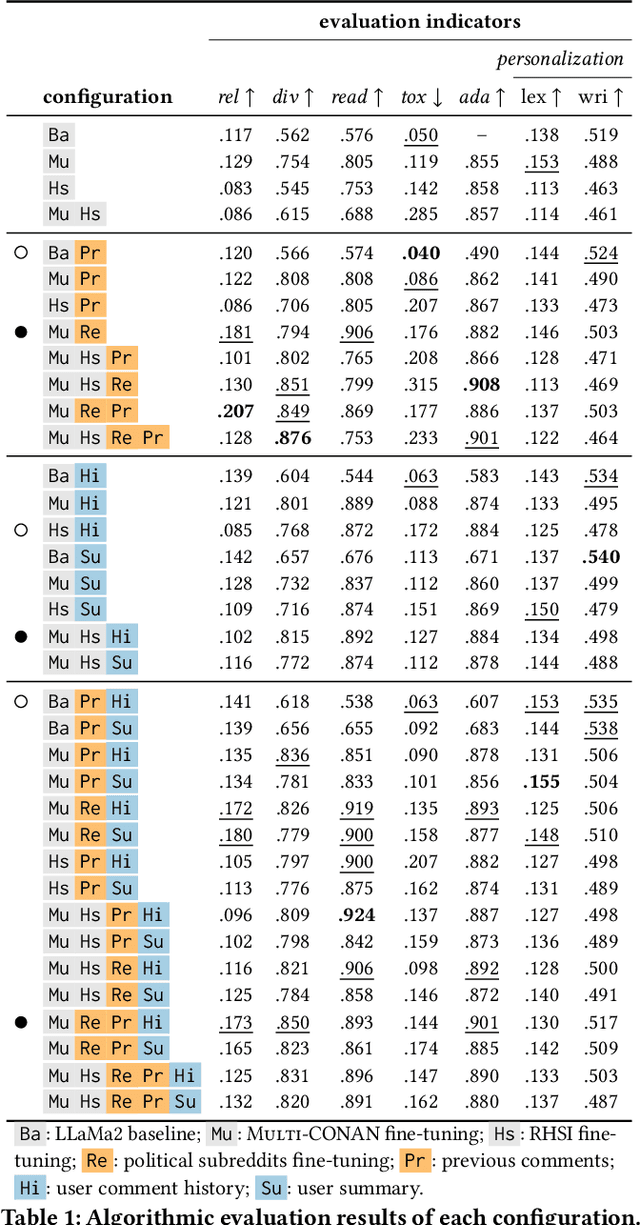
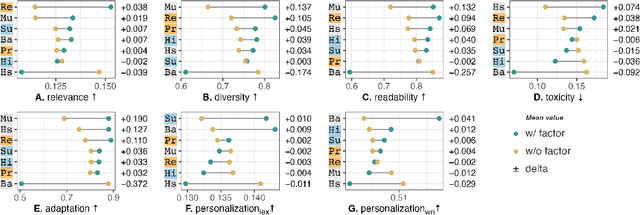
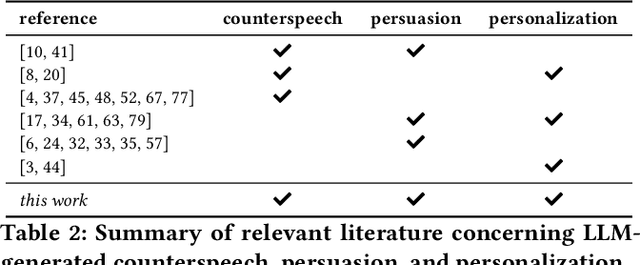
Abstract:AI-generated counterspeech offers a promising and scalable strategy to curb online toxicity through direct replies that promote civil discourse. However, current counterspeech is one-size-fits-all, lacking adaptation to the moderation context and the users involved. We propose and evaluate multiple strategies for generating tailored counterspeech that is adapted to the moderation context and personalized for the moderated user. We instruct an LLaMA2-13B model to generate counterspeech, experimenting with various configurations based on different contextual information and fine-tuning strategies. We identify the configurations that generate persuasive counterspeech through a combination of quantitative indicators and human evaluations collected via a pre-registered mixed-design crowdsourcing experiment. Results show that contextualized counterspeech can significantly outperform state-of-the-art generic counterspeech in adequacy and persuasiveness, without compromising other characteristics. Our findings also reveal a poor correlation between quantitative indicators and human evaluations, suggesting that these methods assess different aspects and highlighting the need for nuanced evaluation methodologies. The effectiveness of contextualized AI-generated counterspeech and the divergence between human and algorithmic evaluations underscore the importance of increased human-AI collaboration in content moderation.
Leveraging Large Language Models for Mobile App Review Feature Extraction
Aug 02, 2024



Abstract:Mobile app review analysis presents unique challenges due to the low quality, subjective bias, and noisy content of user-generated documents. Extracting features from these reviews is essential for tasks such as feature prioritization and sentiment analysis, but it remains a challenging task. Meanwhile, encoder-only models based on the Transformer architecture have shown promising results for classification and information extraction tasks for multiple software engineering processes. This study explores the hypothesis that encoder-only large language models can enhance feature extraction from mobile app reviews. By leveraging crowdsourced annotations from an industrial context, we redefine feature extraction as a supervised token classification task. Our approach includes extending the pre-training of these models with a large corpus of user reviews to improve contextual understanding and employing instance selection techniques to optimize model fine-tuning. Empirical evaluations demonstrate that this method improves the precision and recall of extracted features and enhances performance efficiency. Key contributions include a novel approach to feature extraction, annotated datasets, extended pre-trained models, and an instance selection mechanism for cost-effective fine-tuning. This research provides practical methods and empirical evidence in applying large language models to natural language processing tasks within mobile app reviews, offering improved performance in feature extraction.
Linguistic Knowledge Can Enhance Encoder-Decoder Models (If You Let It)
Feb 27, 2024
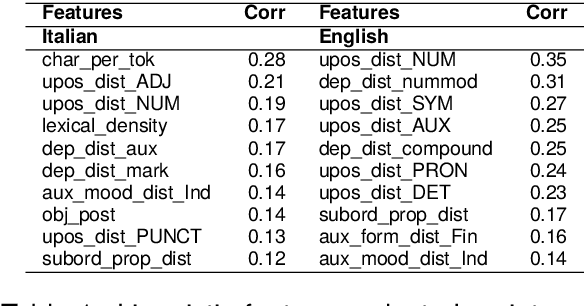
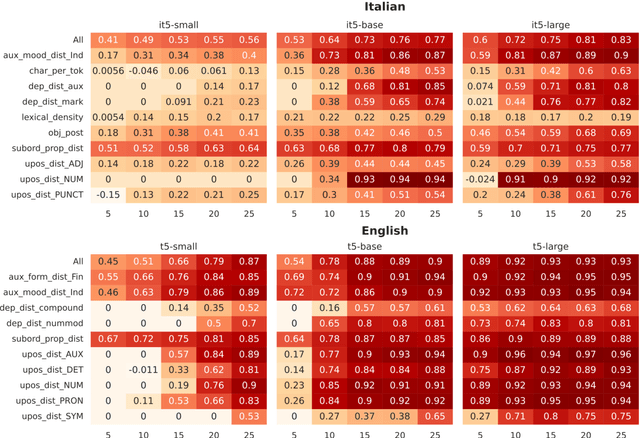
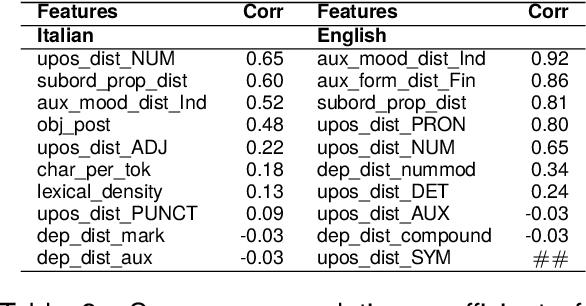
Abstract:In this paper, we explore the impact of augmenting pre-trained Encoder-Decoder models, specifically T5, with linguistic knowledge for the prediction of a target task. In particular, we investigate whether fine-tuning a T5 model on an intermediate task that predicts structural linguistic properties of sentences modifies its performance in the target task of predicting sentence-level complexity. Our study encompasses diverse experiments conducted on Italian and English datasets, employing both monolingual and multilingual T5 models at various sizes. Results obtained for both languages and in cross-lingual configurations show that linguistically motivated intermediate fine-tuning has generally a positive impact on target task performance, especially when applied to smaller models and in scenarios with limited data availability.
A dissemination workshop for introducing young Italian students to NLP
May 14, 2021

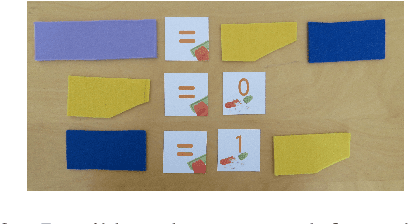
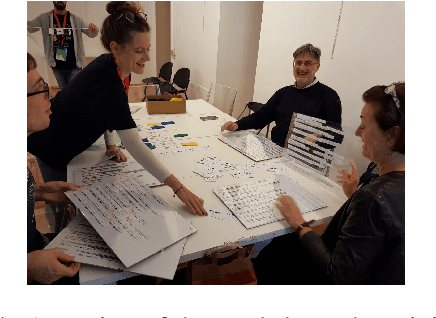
Abstract:We describe and make available the game-based material developed for a laboratory run at several Italian science festivals to popularize NLP among young students.
Teaching NLP with Bracelets and Restaurant Menus: An Interactive Workshop for Italian Students
May 14, 2021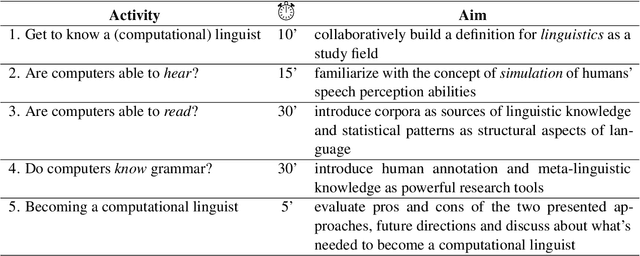
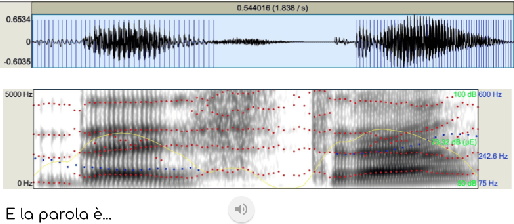

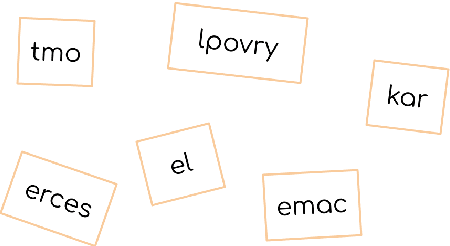
Abstract:Although Natural Language Processing (NLP) is at the core of many tools young people use in their everyday life, high school curricula (in Italy) do not include any computational linguistics education. This lack of exposure makes the use of such tools less responsible than it could be and makes choosing computational linguistics as a university degree unlikely. To raise awareness, curiosity, and longer-term interest in young people, we have developed an interactive workshop designed to illustrate the basic principles of NLP and computational linguistics to high school Italian students aged between 13 and 18 years. The workshop takes the form of a game in which participants play the role of machines needing to solve some of the most common problems a computer faces in understanding language: from voice recognition to Markov chains to syntactic parsing. Participants are guided through the workshop with the help of instructors, who present the activities and explain core concepts from computational linguistics. The workshop was presented at numerous outlets in Italy between 2019 and 2021, both face-to-face and online.
Linguistic Profiling of a Neural Language Model
Oct 30, 2020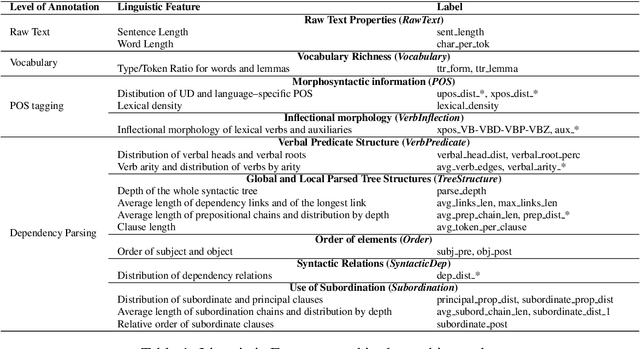
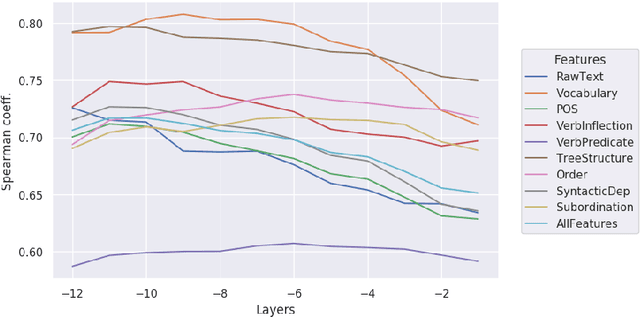

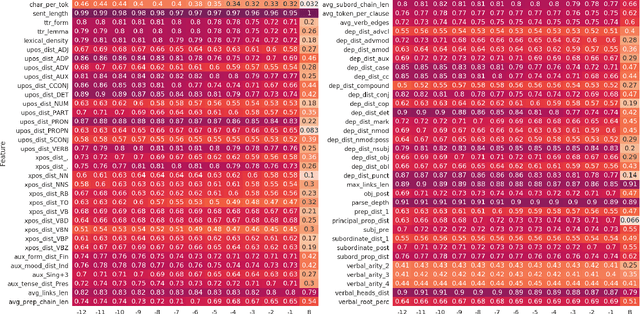
Abstract:In this paper we investigate the linguistic knowledge learned by a Neural Language Model (NLM) before and after a fine-tuning process and how this knowledge affects its predictions during several classification problems. We use a wide set of probing tasks, each of which corresponds to a distinct sentence-level feature extracted from different levels of linguistic annotation. We show that BERT is able to encode a wide range of linguistic characteristics, but it tends to lose this information when trained on specific downstream tasks. We also find that BERT's capacity to encode different kind of linguistic properties has a positive influence on its predictions: the more it stores readable linguistic information, the higher will be its capacity of predicting the correct label.
 Add to Chrome
Add to Chrome Add to Firefox
Add to Firefox Add to Edge
Add to Edge